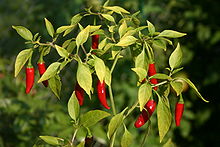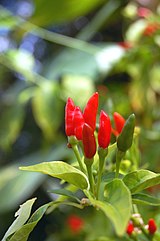Bird's eye chili: Difference between revisions
No edit summary |
Paulius.sky (talk | contribs) m Fixed vandamlism |
||
| Line 4: | Line 4: | ||
{{Contains Thai text}} |
{{Contains Thai text}} |
||
[[File:Thai peppers.jpg|thumb|Bird's Eye Chili]] |
[[File:Thai peppers.jpg|thumb|Bird's Eye Chili]] |
||
its birdseye chilli not birdeye tony mckean |
|||
{{Pepper |
{{Pepper |
||
| boxwidth=250px |
| boxwidth=250px |
||
Revision as of 12:07, 2 March 2010
This article's factual accuracy is disputed. (November 2009) |
The examples and perspective in this article may not represent a worldwide view of the subject. (November 2009) |

| Bird's eye chili | |
|---|---|
| Heat | Very Hot (SR: 50,000-100,000) |
Bird's eye chili (Thai: พริกขี้หนู, RTGS: phrik khi nu, literal: mouse dropping chili, Tagalog: siling labuyo) is a chili pepper of the species Capsicum frutescens L. in the family Solanaceae, commonly found in Cambodia, Laos, Vietnam, Thailand, Malaysia, Indonesia, the Philippines and Singapore. It can also be found in India, mainly Kerala, where it is used in traditional dishes of the Kerala cuisine (pronounced in Malayalam as kanthari mulagu).
Cultivars
Description

The bird's eye chili plant is a perennial with small, tapering fruits, often 2-3, at a node. The fruits of most varieties are red, some are yellow, purple or black. The fruits are very pungent. The flowers are greenish white or yellowish white.[1]
Taxonomically, it has long been thought that the bird's eye chili belongs to Capsicum frutescens L.,[2][3][3] but there are now some who list the bird's eye chili as belonging to Capsicum chinense.[4]
The bird's eye chili is small but packs quite a lot of heat. At one time it was even listed as the hottest chili in the Guinness Book of World Records but other hotter varieties of chili have since been identified. It measures around 50,000-100,000 Scoville units which is at the lower end of the range for the hotter habanero chili.
Common names
The chilies may also be referred to as cili padi (cili pronounced "chili") in Malay because their small size reminds people of the small grained rice eaten as a staple in the region.
As well as the Malay word, Thai chilies can also be referred to as cabe rawit (Indonesian), phrik khi nu (พริกขี้หนู, Thai), Thai hot, Thai dragon (due to its resemblance to claws), siling labuyo (Filipino), ladâ, and boonie pepper (the Anglicized name).
Uses
Cooking
The fruit of the bird's eye chili is popularly used as a spicy and chili condiment while its leaves are usually consumed as vegetables.[5] It's what gives local dishes such as bicol express their fiery zing[6]. It is also used to flavor vinegar.
Ornamentals

The more decorative, but slightly less pungent variety, sometimes known as Thai Ornamental, has peppers that point upward on the plant, and go from green to yellow, orange, and then red. It is the basis for the hybrid Numex twilight, essentially the same but less pungent and starting with purple fruit, creating a rainbow effect, and among the group of Capsicum annuum. These peppers can grow wild in places like Saipan and Guam. The Chinese in Southeast Asia call this pepper 'the chili that points to the sky'.
Medicine
In medicinal terms, the chili was earlier utilized as an herbal plant to ease arthritis and rheumatism. Likewise, the bird's eye chili is suggested to be an effective cure for dyspepsia, flatulence, and toothache.[5]
It can also be used as a natural insect repellent or pesticide when mixed with water.[7][8]
References
- ^ Hot Pepper
- ^ Capsicum Frutescens Linn. Sileng-Labuyo
- ^ a b Chile Varieties Database
- ^ DeWitt, Dave and Bosland, Paul W.: Peppers of the World: An Identification Guide, page 63. Ten Speed Press. 1996. ISBN 0898158400. Retrieved 2009-10-25.
- ^ a b Nagpala, Ellaine Grace. (2007). A fresh look at siling labuyo. BAR Chronicle 8(10). Retrieved 2009-10-22.
- ^ Recipe for Bicol Express. Retrieved 2010-01-05.
- ^ Aguilar, Ephraim. (2007-5-31). School teaches love for environment. Philippine Daily Inquirer. Retrieved 2009-10-22.
- ^ Organic Farming
